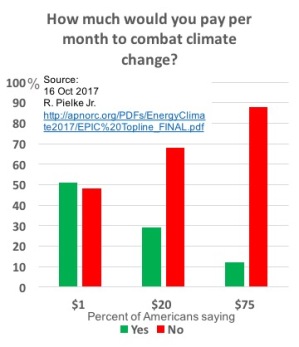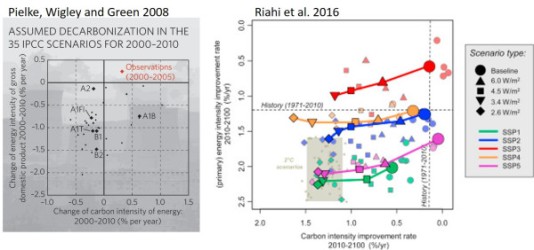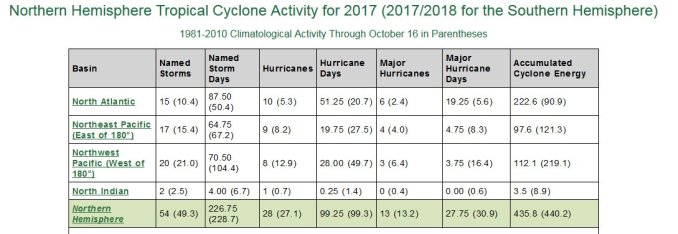
Welcome to issue #6 of my occasional newsletter on climate and energy issues. The above image comes from a recent public opinion survey on climate change from AP/NORC (here in PDF). The data shows that the Iron Law of Climate Change is alive and well. People are willing to pay some economic price for action on climate change, but that willingness is extremely limited. Only 12% of Americans say that they’d be willing to pay $75 per month, and only 52% say they be willing to pay $1 per month. The Iron Law provides a very useful boundary condition for thinking about policy design.
As a reminder, my day-to-day research or writing is focused on sports governance and various issues of science policy. But I’ve written a fair bit on the topics of climate and energy over the past 25 years, including two recent books and a boatload of academic papers, and I’m paying attention. So caveat lector!
A few things to say up front:
- If you appreciate the perspective, consider the tip jar to your right.
- If you don’t like what I write or don’t like me, then don’t read it – no big deal, I’m just a professor with a blog.
- And thanks to those of you who have tipped – very much appreciated
- If you’d like to engage, consider a comment, Tweet @ me (@rogerpielkejr) or an email. I am happy to discuss or debate. I’ve had great feedback on the first 5 issues.
- Also, if you have a pointer or tip, please send that along as well.
- Social media warning: if you choose to call me names or lie about me, oh-so-common in discussing climate, then you will be blocked or ignored.
The next edition of this newsletter will come in November.
With that, some of what I found interesting over the past month . . .
Emissions intensity assumptions and projections
- Pretis and Roser (2017) conclude that “global emission intensity (fossil fuel CO2 emissions per GDP) rose in the first part of the 21st century despite all major climate projections foreseeing a decline.”
- This analysis further confirms the work we did in Pielke et al. (2008) (“Dangerous Assumptions” here in PDF) in which we argued that “IPCC assumptions for decarbonization in the short term (2000–2010) are already inconsistent with the recent evolution of the global economy.”
- Our 2008 paper was the subject of a sustained effort of delegitimization by the Center for American Progress and members of the media. The image below is from 2008, near the start of CAP’s 170+ article effort to delegitimize my work over many years.

- Despite this effort by CAP and fellow travelers, it looks like the IPCC has now adopted our recommended approach going forward, based on the Kaya Identity decomposition of emissions. See Riahi et al. (2017), from which the figure below right is taken (the panel on the left is from Pielke et al. 2008). Sometimes it takes a while, but good science stands the test of time.

- Watch out for loose talk of emissions and GDP having “decoupled” (no, they haven’t) and pay attention instead to quantified rates of decarbonization, decomposed into energy intensity (energy/GDP) and carbon intensity (carbon/energy). Ultimately progress towards stabilizing carbon dioxide in the atmosphere is best measured by rates of decline in C/GDP.
Hurricanes
- In July, I warned in an essay at Risk Frontiers that bigger disasters we coming. I didn’t know that they’d be coming so soon.
- Phil Klotzbach of CSU has the active 2017 North Atlantic hurricane season into historical perspective.

- Klotzbach puts these numbers into a Norther Hemisphere persepctive, and the active season turns into a pretty ordinary one.

- It is very preliminary, but based on estimates from AIR Worldwide for losses from this year’s hurricane season, we can estimate (assuming total = 2x insured) that they will total about $300B (US and beyond). If we add in another $100B for other events (earthquakes, floods, fires, etc.) that would take the world to about 0.4% of global GDP, making 2017 the costliest disaster year (as % GDP) since 2005.
- Of course, 2017 could yet exceed 2005.
- On the mainland US, hurricane damage could exceed $150B. However, it is important to understand that the US NWS keeps separate tabulations for flood damage and hurricane damage, so Harvey in particular will have its accounts in two categories. This doesn’t matter to those who suffered the impacts of Harvey, but it does have some implications for research that tries to compare impacts over time in apples-to-apples fashion.
- Here is a sneak-peak at a table from a paper in progress in which we are updating our normalized hurricane loss dataset through 2017. At this point, it looks like both Harvey’s and Irma’s total costs will put them into the top 10 of normalized US losses, but not into the top 5. If flood losses are indeed determined not to be apples-to-apples with this dataset, then Harvey could fall out of the top 25. Our paper will be submitted in December, after hurricane season.

- The response to Hurricane Maria in Puerto Rico continues to stand out as a remarkable failure of US governing and leadership. How can the US government be so incompetent and the president so callous? Remarkable on both counts.
Ocean Heat Content and Science Ethics
- Last month a group of scientists published an article in EOS (newsletter of the AGU) with a fantastic idea: “we suggest that scientists and modelers who seek global warming signals should track how much heat the ocean is storing at any given time, termed global ocean heat content (OHC)” (Cheng et al. 2017). Brilliant.
- In a companion piece in The Guardian one of the article’s co-authors, John Abraham, explained, “This finding should help change the way we talk about global warming.” Damn straight.
- But . . . As anyone familiar with climate science should well know, the idea to monitor ocean heat content as a metric of human-caused global warming that is far better than surface temperatures was first presented by my father in 2003 in BAMS.
- Perhaps Cheng et al. simply discovered this new “finding” on their own. Yeah, no.
- Pielke Sr. engaged in many years of advocacy for the use of ocean heat content as a metric of global warming on his blog, most notably with Cheng et al. co-author Kevin Trenberth. See: here, here, here, here, here and here — just for a few. So Trenberth was fully aware of the intellectual history of this idea. Trenberth was among a number of scientists to criticize the idea. And yet Pielke Sr. persisted.
- In August of 2016, Pielke Sr. corresponded with Cheng, and observed cordially that several of Cheng and colleagues’ papers had failed to cite properly his early work on OHC.
- Cheng responded just as cordially: “I’m so sorry we fail to cite your papers, I will read those paper and do cite in our future studies” (sic). So Cheng was also aware of the intellectual history of the idea and had expressed an intent to properly cite that history in the future.
- OK, mistakes happen, references are sometimes overlooked. Yeah. no.
- On September 27, 2017, Pielke Sr. emailed Barbara Richman, EOS Editor in Chief, to inquire about the citation oversight. Richman responded with this (emphasis added): “Earlier today I talked to several of the authors of [Cheng et al. 2017] and asked if they would consider updating their Opinion with additional references. They have expressly stated that they do not wish to do so. “
- No shit, Sherlock — That is the problem here.
- In parallel, as a test of the system I emailed the AGU Ethics Committee, noting my concern about the “wholesale appropriation of ideas first presented in the Bulletin of the American Meteorological Society in 2003 by Roger Pielke Sr.” The AGU Ethics Committee helpfully explains to its members that “An ethical writer ALWAYS acknowledges the contributions of others to his/her work.”
- ALWAYS (got that?)
- The AGU Ethics Committee sent my note to Barbara Richman (I kid you not) to adjudicate and to respond. She of course summarily dismissed the concern, explaining: “Eos is not a research journal, and therefore, it is not necessary to document meticulously all sources.” So NOT ALWAYS? I have a hard time squaring this with the AGU Ethics guidelines, but whatevs.
- In 1868 Dr. J. Marion Sims explained what is going on here: “For it is ever so with any great truth. It must first be opposed, then ridiculed, after a while accepted, and then comes the time to prove that it is not new, and that the credit of it belongs to some one else.”
- Pielke Sr.’s academic record speaks for itself. Unfortunately, in the vicious world of climate science, it has to. Climate science ain’t beanbag.
Until next time …
